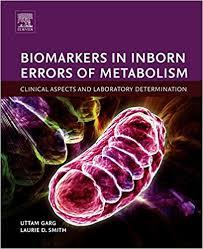- Print Length: 476 pages
- Publisher: Elsevier; 1 edition (June 7, 2017)
- Publication Date: June 7, 2017
- Language: English
Biomarkers in Inborn Errors of Metabolism: Clinical Aspects and Laboratory Determination 1st
$15
by Uttam Garg
-
-
- Provides comprehensive information on the tests/biomarkers selection in newborn screening and follow-up of newborn screens
- Categorizes biomarkers into diagnostic markers, disease follow-up markers, and prognostic biomarkers
- Covers confounding factors that can alter biomarkers in the absence of inborn errors of metabolism
- Offers guidance on how to distinguish acquired causes from inborn errors of metabolism
-
Biomarkers in Inborn Errors of Metabolism: Clinical Aspects and Laboratory Determination 1st
by Uttam Garg (Author), Laurie D. Smith (Author)
Biomarkers of Inborn Errors in Metabolism: Clinical Aspects and Laboratory Determination is structured around the new reality that laboratory testing and biomarkers are an integral part in the diagnosis and treatment of inherited metabolic diseases. The book covers currently used biomarkers as well as markers that are in development. Because biomarkers used in the initial diagnosis of disease may be different than the follow-up markers, the book also covers biomarkers used in both the prognosis and treatment of inherited metabolic disorders.
With the introduction of expanded new-born screening for inborn metabolic diseases, an increasing numbers of laboratories are involved in follow-up confirmatory testing. The book provides guidance on laboratory test selection and interpreting results in patients with suspected inherited metabolic diseases. The book provides comprehensive guidance on patient diagnosis and follow-up through its illustrative material on metabolic pathways, genetics and pathogenesis, treatment and prognosis of inherited metabolic diseases, along with essential information on clinical presentation.
Each chapter is organized with a uniform, easy-to-follow format: a brief description of the disorder and pathway; a description of treatment; biomarkers for diagnosis; biomarkers followed for treatment efficacy; biomarkers followed for disease progression; confounding conditions that can either: affect biomarker expression or mimic IEMs; other biomarkers: less established, future.
Product details |
Related Products
Basic Sciences Books
Fundamentals of Pathology of Skin, 5th Edition (Original PDF from Publisher)
Basic Sciences Books
Lever’s Dermatopathology: Histopathology of the Skin, 12th Edition (EPUB3)
Basic Sciences Books
Robbins & Kumar Basic Pathology, 11th edition (Original PDF from Publisher) and video
Pathology Books
Diagnostic Pathology: Endocrine, 3rd edition 2022 Original PDF
Pathology Books
HEAD AND NECK SURGERY & OTOLARYNGOLOGY
Diagnostic Pathology: Head and Neck, 3rd Edition 2022 Original PDF
Pathology Books
Pathology Books
Atlas of Hepatocellular Carcinoma Pathology 2022 Original pdf
Pathology Books
Pathology Books
Pathology Books
Pathology Books
Pathology Books
Pathology Books
Pathology Books
Diagnostic Pathology: Thoracic, 3rd edition 2022 Original PDF
Pathology Books
Pathology Books
Pathology Books
The Voice and Voice Therapy (10th Edition) 2019 Original pdf
Pathology Books
Pathology Books
Pathology Books
Pathology Books
Pathology Books
Pathology Books
Pathology Books
Diagnostic Cutaneous Pathology, 2 Volume Set 2021 Original PDF
Pathology Books
Pathology Books
Pathology Books
Lever’s Histopathology of the Skin Eleventh Ed 2021 Original pdf
Pathology Books
Pathology Books
Pathology Books
Diagnostic Pathology of Infectious Disease 2018 Original pdf
Pathology Books
Pathology Books
Pathology Books







































































































